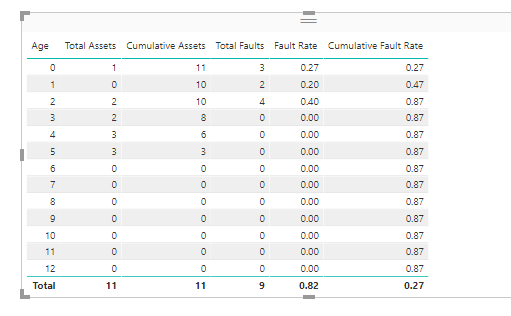Hi Fellow Power BI Users -
I am trying to create a cumulative sum of a measure that itself calculates a cumulative sum (all of which needs to be sliceable).
A table view of the data/measures I have created is in the attached image (I can provide a sample pbix file which illustrates my problem if that would be helpful)
Where:
Age column is pulled in straight from a Table.
Total Assets is a simple measure: Total Assets = COUNT(Assets[Age]) + 0
Cumulative Assets was generated using the quick measure running total:
Cumulative Assets =
CALCULATE(
[Total Assets],
FILTER(
ALLSELECTED('Age Table'[Age]),
ISONORAFTER('Age Table'[Age], MAX('Age Table'[Age]), ASC)
)
)
Total Faults is a simple measure: Total Faults = COUNT(Faults[Age at Fault]) + 0
Fault Rate is a simple measure: Fault Rate = DIVIDE([Total Faults],[Cumulative Assets]) + 0
The desired goal is to have “Cumulative Fault Rate” calculate a running total of the Fault Rate as a function of age.
The column should contain [0.27, 0.47, 0.87, 0.87, 0.87…]
I have tried to implement using the quick measure running total:
Cumulative Fault Rate =
CALCULATE(
[Fault Rate],
FILTER(
ALLSELECTED('Age Table'[Age]),
ISONORAFTER('Age Table'[Age], MAX('Age Table'[Age]), DESC)
)
)
As the table shows, the “Cumulative Fault Rate” column is not showing what I want…
Finally, I would like the measures to be dynamic with the model slicer (I am assuming that is where the “ALLSELECTED” function fits in…)
Apologies if this has been covered, I did read a couple of other threads and tried to solve on my own…but couldn’t get it working.
Thanks,
Matt



